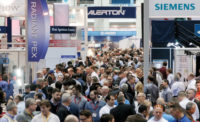WESTPORT, Conn. — Responses from a 2016 AHR Expo survey sent to 1,300 exhibitors reveal optimism for the coming year among HVACR manufacturers.
The survey asked HVACR equipment manufacturers to consider what they anticipate the business climate will be for the industry — regarding their sales, market segment activity, and overall expectations — for 2016. Results were compared to a similar survey sent out last year that gauged exhibitors’ expectations for 2015. While some answers varied from year to year by only slight percentage points in either direction, others were drastically different, representing changes and future trends in the industry.
According to the survey, 86 percent of exhibitors are confident about their business prospects in 2016, with 14 percent answering “excellent” and 62 percent selecting “good.” Only 14 percent rated conditions poor or had no opinion. These numbers, particularly the percentage of “good” answers, are fairly consistent with 2015’s survey, which showed a significant growth in optimism from previous years.
Exhibitors also expressed positive outlooks when asked about their expectations of sales growth in the new year based on prospective clients. Eight-one percent expected to see an increase in sales. Of those, 21 percent predicted 10 percent growth while 33 percent anticipated 5-10 percent growth.
In keeping with the positive outlook for industry growth in 2016, 67 percent of HVACR manufacturers responding to the survey said they plan to introduce a new product at the 2016 AHR Expo in January. Of those new products, 53 percent aim to improve energy efficiency.
The survey question asking, “In general, how much are government and/or utility incentives helping to increase the adoption of energy-efficient products and technologies?”, leant additional insight in this regard. Fifty-eight percent answered “some,” 28 percent said “very little,” and 5 percent responded “not at all,” while only 9 percent said “a lot.” This feedback shows that the industry would welcome and appreciate more help from incentive programs in the coming year.
When manufacturers were asked about their viewpoints on various market segments in the new year, data and telecom centers, hospitals, and health care facilities all tied with the residential market for best outlook overall. All were rated “excellent” or “good” by 65 percent of respondents. Data and telecom centers and residences were both rated “excellent” by 10 percent and “good” by 55 percent, while hospitals and health care facilities ratings were 16 percent and 49 percent, respectively. Closely following in ratings were light commercial and office buildings with 62 percent each and heavy commercial with 60 percent “excellent” and “good” ratings. These percentages indicate stability in the industry, as they are on par with last year’s survey results showing the strongest outlooks in the same markets.
When it came to the anticipated best potential for business in 2016, responses skewed from those of 2015’s survey. Forty-two percent of respondents selected “retrofit and renovations” as the most opportunistic area of the industry, up 14 percentage points from last year. Thirty percent selected “new construction,” which was last year’s No. 1 answer. “Maintenance and replacement” decreased from 32 to 28 percent.
“Numbers like these represent the ever-changing needs of this vast, complex industry,” said Clay Stevens, president of International Exposition Co. “Yes, the market segments have stayed consistent, but their needs haven’t. We are seeing less new construction and a jump in demand for renovations in existing structures. Much of this comes from a market-wide push for energy efficiency and conservation of resources, which I am pleased to see. The trend of improved energy efficiency in products lends hope to the future in regard to streamlining energy usage worldwide.”
The next question asked manufacturers to rate the importance of various product features to their customers. Leading the pack of what customers considered “very important” was reliability with 87 percent. An additional 11 percent said reliability was “somewhat important.” The playing field was evened out when totals of “very important” and “somewhat important” were calculated. Energy efficiency, indoor air quality, maintenance, and first cost totals all fell in the 93- to 98-percent range. Comfort was considered important to 90 percent of customers and sustainability to 82 percent. When it came to use of recycled materials in the product or its packaging, answers were evenly split, with 50 percent considering it important and 50 percent selecting “not important.”
Examining customers’ needs along with the needs of the industry as a whole, exhibitors’ responses provide a more in-depth understanding of industry trends. When exhibitors almost unanimously agree that reliability is very important to customers, for example, it indicates a trend of engineering and manufacturing to greater reliability across HVACR industry products.
A final, open-ended question asked manufactures what they perceive to be the most important trend or issue in the current HVACR industry. Responses included: renewable fuels, the expansion of the Internet of Things (IoT), building automation, product cost and education, training and recruitment of HVACR staff. At-large, the most common answer was energy efficiency, suggesting that 2016 may see a shift in focus toward creating even more energy-efficient products and technology industry-wide.
For more information about the AHR Expo, visit www.ahrexpo.com.
Publication date: 12/29/2015
Want more HVAC industry news and information? Join The NEWS on Facebook, Twitter, and LinkedIn today!









